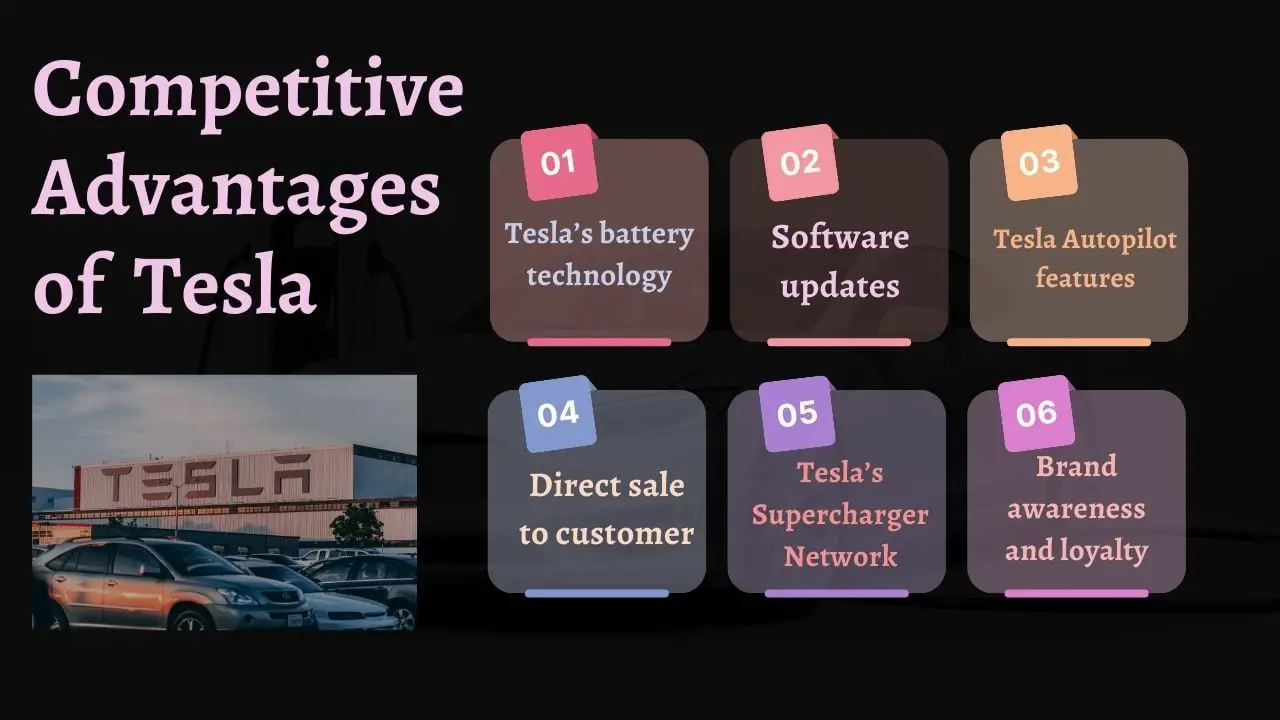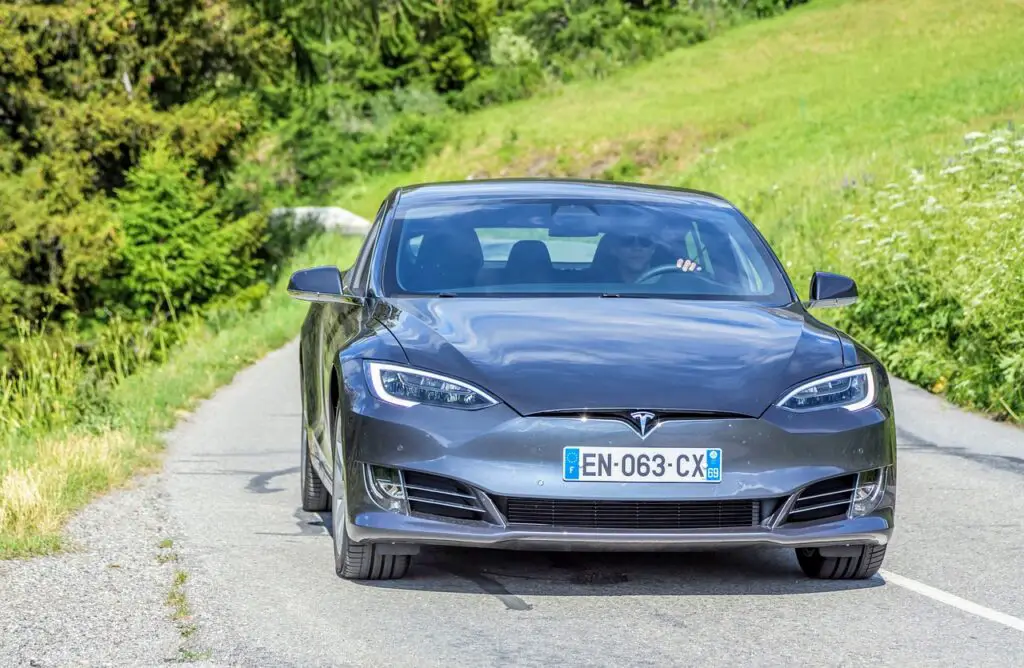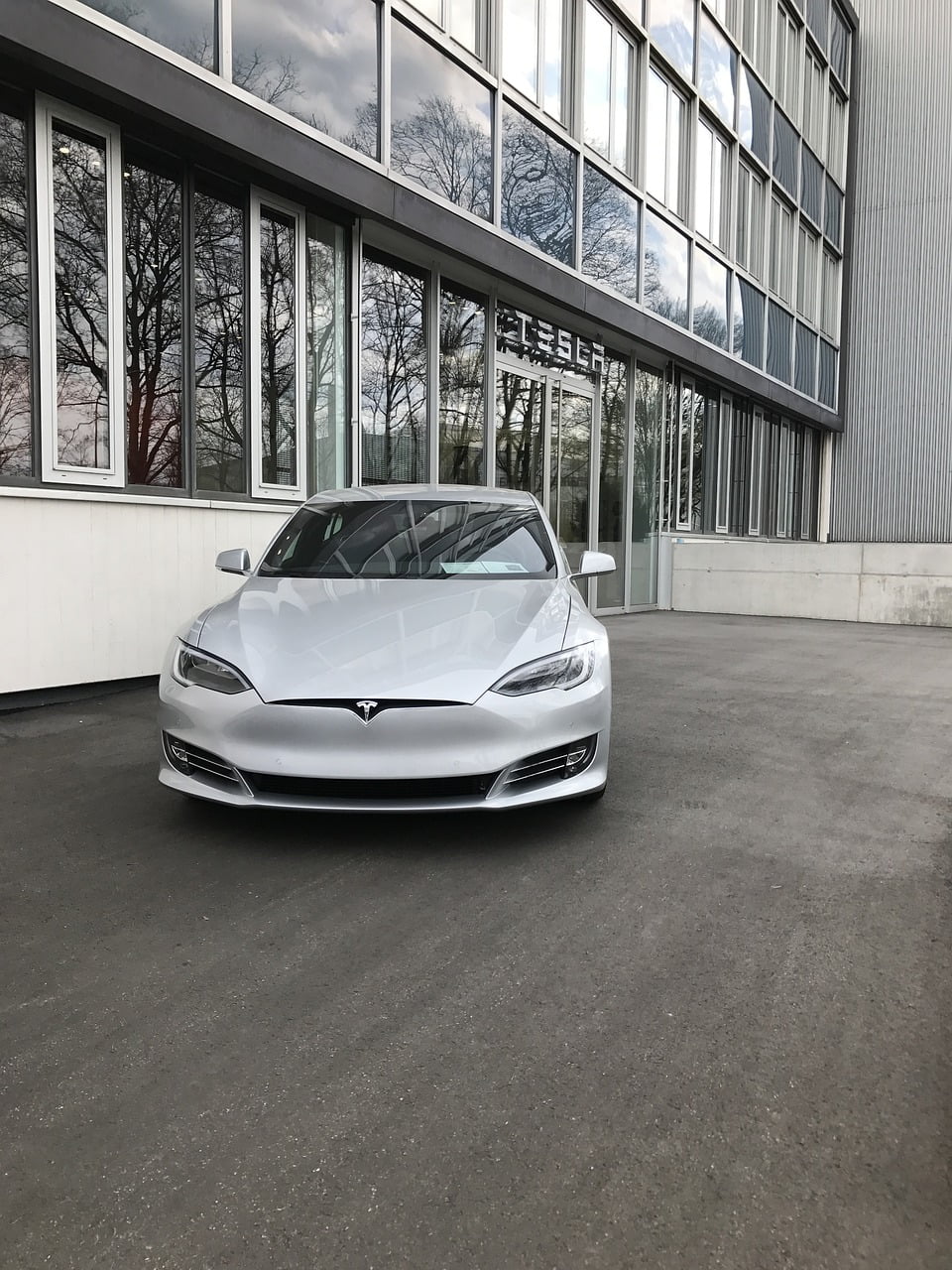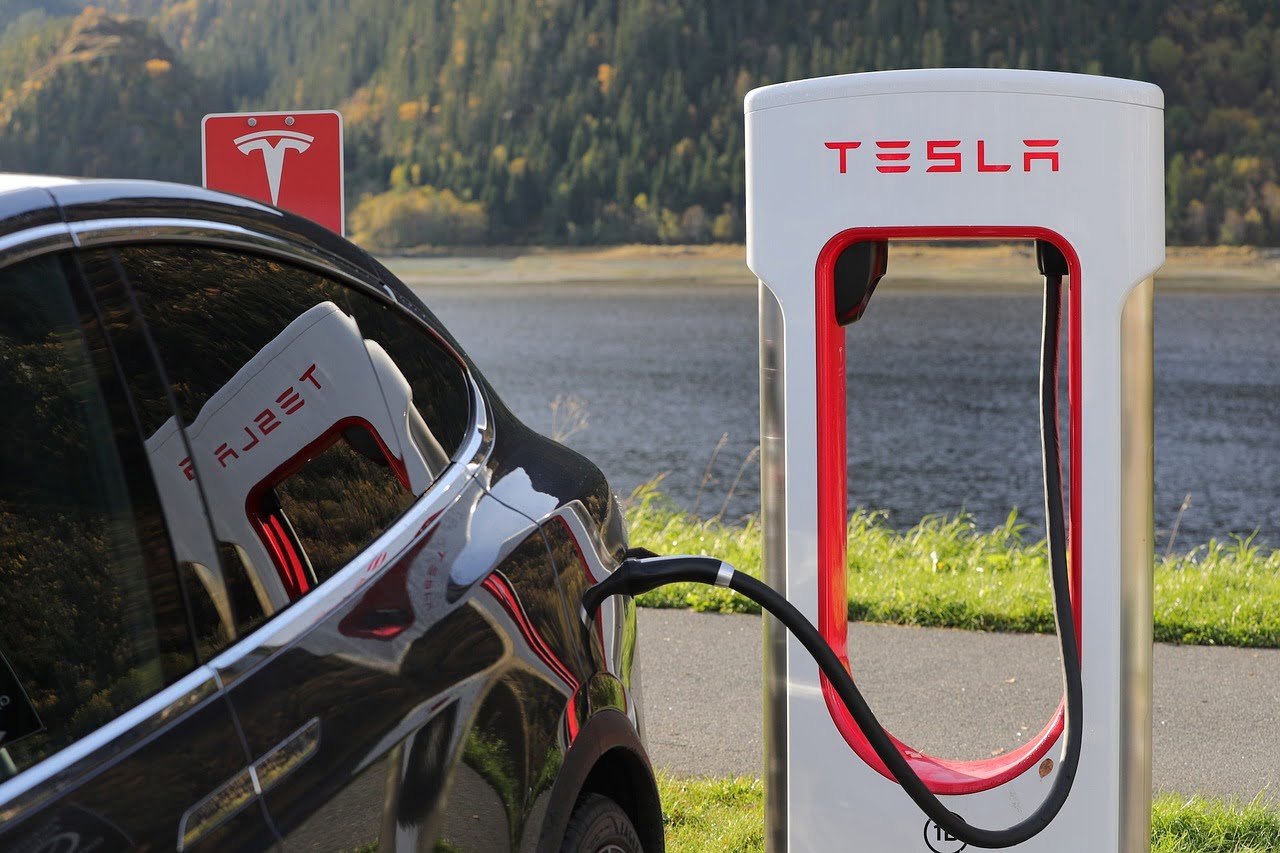Tesla Incorporation was founded in July 2003 and has since then grown exceptionally to become one of the leading manufacturers of electric vehicles in the United States. As a result of Tesla competitive advantage and strategy, the company has achieved so many milestones that have made it a key player in the electric vehicle (EV) industry.
This American multinational automotive and clean energy company specializes in the manufacture and sale of electric vehicles, energy storage systems, and solar panels. According to Elon Musk, Tesla’s CEO, the company’s mission is to:
Accelerate the advent of sustainable transport by bringing compelling mass-market electric cars to market as soon as possible.
https://www.tesla.com/blog/mission-tesla
Tesla’s Model S, Model X, and Model 3 cars have gathered high sales that have enhanced the company’s success. The continued growth of the automaker can be attributed to its competitive strategies and business structure.

Tesla’s competitive advantages have made it a market leader in software for autonomous driving. The company is also a market leader in production efficiency, data collection, AI and autopilot, supercharging network, and sales models. We will be discussing what makes Tesla different from its competitors and the vertical integration strategies that the company uses.
Related: McDonald’s Competitive Advantage
What is Tesla’s competitive strategy?
Tesla’s competitive strategy is a differentiation strategy. This gives the company a competitive advantage which is based on the manufacture and development of products that makes Tesla different from its competitors. This company, unlike other automakers, invented a successful business model for bringing electric cars to the market.
A company’s competitive strategy is a plan of action that the company uses to gain a competitive advantage in the market. It is the process of identifying and executing actions to improve the company’s competitive position in its industry.
Michael Porter, a Harvard professor and author, strongly influenced the study of business strategy. Porter’s generic strategies explain how a company pursues competitive advantage either by differentiating its products along dimensions valued by customers in order to command a higher price or by lowering its product costs than its competitors.
A company can, therefore, choose to pursue competitive advantage in four different ways- differentiation leadership strategy, differentiation focus strategy, cost leadership strategy, and cost focus strategy.
Tesla chooses to use a differentiation strategy by providing unique features of its products for a specific target market.
Tesla’s differentiation leadership strategy
Companies can differentiate their products from their competitors by emphasizing specific features of their products. This is known as a differentiation leadership strategy.
A company that has been in operation for a while can use this strategy to show that an original offering is better than newer products or a newer company can utilize this strategy to show that a new invention is better than the existing offerings. By using this type of competitive strategy, Tesla differentiates itself from other companies.
For example, one of Tesla’s competitive advantages is its advanced technology. The company is competitive because it was able to integrate advanced environmentally friendly technology, considering that its competitors use internal combustion engines. In using this competitive strategy, Tesla attracts all potential customers that are increasingly interested in environmentally friendly products.
The goal of Tesla using a differentiation leadership strategy is to use unique features and quality to appeal to more customers while keeping competitors from obtaining a larger market share for products. This strategy has proven to be successful so far as the company has four EVs that own part of the electric vehicle market.
Three of Tesla’s EVs were among the top five selling cars as of October 2022. The top-selling cars were:
- Tesla Model Y (30.4% market share)
- Tesla Model 3 (27.8%)
- Ford Mustang Mach-E (5.6%)
- Tesla Model S (4.6%)
- Hyundai IONIC 5 (3.8%)
This proves that Tesla’s competitive strategy gives it a larger market share than most of its competitors. As a matter of fact, even its Model X ranked eighth with 3.3% of the market share. The company has been able to increase its market share over the years, by increasing investment in research and development (R&D) in order to develop new products that satisfy market demand for enhanced renewable energy solutions.
Tesla’s differentiation focus strategy
The differentiation focus strategy just like the differentiation leadership strategy, attempts to highlight unique product features. The only difference is that the differentiation focus strategy involves appealing to a specific market segment while the differentiation leadership strategy involves appealing to a broader market.
Some companies use the cost-focus strategy wherein they provide the lowest price in a small niche (geographic markets), to have a competitive advantage. Tesla, however, doesn’t use a cost-focus strategy, and this is why the cost of its products is exorbitant for the average consumer. As a matter of fact, the company’s cheapest vehicle, the basic Model 3, starts at approximately $45,000.
According to Elon Musk, the company’s first product was going to be expensive no matter what it looked like, so, in order to get the best chance of being competitive with its gasoline alternatives, the company decided to build a sports car.
This particular Tesla’s competitive strategy was a differentiation focus strategy because the company focused on a specific market segment, even though its driving force is its unique value. Hence, the company was able to deliver Tesla Roadster, the first high-performance electric luxury sports car, to the market.
The differentiation focus was Tesla’s initial competitive strategy. The early adopters in the electric vehicle market were the company’s specific market segment. These included affluent customers that have a high tendency to purchase newly introduced products.
However, now that the company’s production costs are declining and it is already popular, Tesla’s competitive strategy has shifted to broadly target customers in the automobile market and not just the early adopters. The company’s declining production costs and increasing brand popularity is, therefore, counted as one of Tesla’s competitive advantages.
See also: Netflix’s Vertical Integration Strategy and Examples
What is Tesla’s competitive advantage?
Tesla’s competitive advantages include the company’s high rate of innovation and advanced technology in its business processes, its strong brand identity, and the strong control of its supply chain stages through a balanced vertical integration strategy.
The automaker invented a successful business model for bringing electric cars to the market. It increases investment in research and development (R&D) in order to develop new products that satisfy market demand. The company’s focus on innovation and technology gives Tesla a competitive advantage over its competitors in the EV market industry.
The company has a team of highly skilled scientists and engineers who work on developing new technologies to help reduce the environmental impact of cars.
Tesla’s vertical integration strategy of building a network of charging stations is one of the company’s main competitive advantages because this innovation solves the challenge of refueling on long trips which is one of the greatest obstacles facing the adoption of electric vehicles.
The company’s strong brand identity for its software-focused, nimble, and rapid innovation model makes it different from traditional car manufacturers and attracts a wide range of customers.
Also, Tesla’s control over sales and service is another major competitive advantage; this is one of the reasons why the company’s stock and shares have soared since its initial public offering.
Read about: Starbucks’ Vertical Integration Strategy
Tesla competitive advantages
- Innovation and technology
- Production efficiency and scale
- Brand awareness and customer loyalty
- Customer-centric approach
- Diversification
- Tesla’s supercharger network
Tesla’s competitive advantages are factors that allow the company to generate more sales or superior margins than its competitors. The above-listed are some of the company’s strengths and strategies that have successfully shaped it as a competitive player in the automotive and energy solutions industry.
We will discuss each Tesla’s competitive advantage below.
Innovation and technology
One major Tesla competitive advantage is its focus on innovation and technology. The automaker has invested heavily in research and development in order to create highly advanced products, such as its autonomous driving, battery technology, and energy storage solutions.
Tesla is one of the companies that use vertical integration. As a vertically integrated company, it develops the majority of its components in-house, such as its motors, batteries, and software. The practice of vertical integration is rare in the automotive industry and this is what makes Tesla different.
Most of its rivals in the automotive industry usually outsource 80% of components to suppliers and only focus on engine manufacturing and final assembly. Hence, one of Tesla’s competitive advantages is to vertically integrate backward by creating innovative components and features in order to surpass its competitors.
Innovative products that give Tesla a competitive advantage
- Battery technology
- Tesla Autopilot features
- Software update
Tesla’s battery

What makes Tesla different from other electric cars is its battery technology. In June 2014, the automaker broke ground on its first battery Gigafactory in Nevada. Currently, the company has six massive Gigafactories in California, Nevada, Germany, China, Texas, and New York, for building batteries and electric vehicles.
The competitive advantage of Tesla in this is that it gives it the opportunity to produce more batteries in terms of kWh than all other car manufacturers combined. Compared to Tesla EV competitors, the company’s batteries are more powerful and efficient, thus, allowing its cars to achieve longer driving ranges.
The company’s continual improvement in its battery chemistry and pack, as well as its partnership with Panasonic Corporation to supply automotive-grade lithium-ion battery cells, also, contributes to Tesla’s competitive advantage over its competitors.
The company’s proven EV battery expertise and the lithium-ion battery cells purchased from Panasonic combine together to develop a next-generation battery cell technology that supplies the highest energy density and best performance cells in the market. Its battery is a game-changer in the industry and is generally considered to be better than others.
The company’s battery technology, therefore, is Tesla’s sustainable competitive advantage over other automakers because the designs of its batteries are modular, thus making them easier to upgrade or replace as needed. This modularity feature also allows the company to reuse the batteries that are no longer suitable for use in cars. This helps to reduce waste and improve the sustainability efforts of the company.
Tesla Autopilot features
Another Tesla competitive advantage is its Autopilot feature. Autopilot technology allows Tesla cars to drive autonomously, thus, making them safer and more efficient compared to traditional cars. The company constantly improves this full self-driving feature and has achieved level 2 autonomy, with level 3 autonomy expected in the near future.
Tesla Autopilot is classified as SAE International Level 2 vehicle automation. This is a suite of advanced driver-assistance systems (ADAS) with features such as:
- Lane centering
- Traffic-aware cruise control
- Automatic lane changes
- Semi-autonomous navigation on limited-access freeways
- Self-parking
- Smart summon
Over the years, Autopilot has been compared with Tesla’s main competitors. The Insurance Institute for Highway Safety in 2018 compared the advanced driver assistance systems of Tesla, Mercedes, BMW, and Volvo. It was observed that the fewest incidents of touching a lane line, crossing over a lane line, or disengaging were experienced in the Tesla Model 3.
Also, Car and Driver, in February 2020 compared Autopilot, Cadillac Super Cruise, and comma.ai. Autopilot was said to be one of the best, due to its user interface and versatility. However, it was criticized for swerving abruptly.
In January 2023, some 12 active driving assistance systems were rated by Consumer Reports and Tesla Autopilot ranked 7th. Nonetheless, Tesla’s autonomous driving capacity is getting better quarter after quarter, as the company regularly adds more autonomous features.
Software updates
Another Tesla competitive advantage is its software updates. The company’s over-the-air updates have continuously improved its electric vehicles.
Tesla’s updates come fairly frequently; the company’s most recent version update (Tesla 2023.26) provides 14 new features. Some of the new software update features include the following:
- Blind spot camera
- Scroll wheel customization
- Destination closing soon
- Spotify refresh
- Bluetooth game controllers
- Warmer display colors
- Automatic headlights
- Charge on solar
- Camera view on Tesla App
Production efficiency and scale
Another competitive advantage of Tesla is its production efficiency and scale. The automaker uses advanced manufacturing techniques to produce its cars and also invests in state-of-the-art production facilities.
Tesla has this competitive advantage over some of its competitors because its factories are highly automated, which allows the company to produce cars more efficiently and at a lower cost.
The company achieves economies of scale as its production scale grows rapidly. This helps to reduce the cost of the company’s products and increase its profit margins.
Brand awareness and customer loyalty
Tesla offers its customers good service and exceptional products. The company has created one of the strongest brands globally, by developing a reputation for producing exceptional products.
This brand has built on its appeal in model after model. No EV brand has an electric car on the market that measures up to the in-house permanent magnet synchronous reluctance motor of the Tesla Model 3 and its performance/price ratio.
The company’s brand appeal is associated with sustainability, innovation, and luxury, and has helped it attract a wide range of customers, including environmentalists, tech enthusiasts, and luxury car buyers. This explains why three of Tesla’s EVs were among the top-selling cars in 2022 and some other years. Its Model S sedan has won nearly every big auto award and has set the stage for the Model 3 and other subsequent models.
A loyal customer base and strong brand image are no doubt one of Tesla’s competitive advantages. The company has a Net Promoter Score (NPS) of 97, which is said to be the highest in the automotive industry. This metric is an indication that Tesla customers are highly satisfied with the products and services that the brand offers, and are likely to recommend the brand to others.
The company’s brand awareness and customer loyalty have also enabled it to overcome some of the challenges associated with being a new entrant in the automotive industry. Tesla’s strong brand and loyal customer base have placed it in a position to be able to compete with established automakers and gain market share.
Customer-centric approach
Tesla differentiates itself from other companies through its customer-centric strategy. The company’s direct sales model enables customers to buy cars directly from the company’s retail stores or website.
This forward vertical integration strategy allows the company to build a direct relationship with its customers, which gives the company an opportunity to understand its customers’ needs and preferences.
Customer-centric strategies that give Tesla a competitive advantage over its competitors
- Direct sales
- Internet sales
- Home Services
Direct Sales

Unlike other automakers that sell their cars through franchised dealerships, Tesla uses a direct sale model wherein it sells directly to consumers. It created an international network of company-owned showrooms, Service Plus centers, and service facilities. As of May 25, 2022, Tesla has about 823 locations of these facilities across the globe.
This is one major competitive advantage of Tesla because it gives a better customer buying experience. Unlike car dealerships, Tesla showrooms have no other car brand on-site, thus erasing any potential conflicts of interest. That is, customers deal with only Tesla-employed sales and service staff.
Internet sales
Another Tesla competitive advantage is its integration of Internet sales into its supply chain process. This makes it convenient for consumers to customize and purchase a Tesla online, thus, simplifying the buying process, and putting the consumer in control.
Buying a Tesla is relatively simple; a reason why Tesla is better than other electric cars. All a customer needs to do is go on the company’s website, pick a model, add his/her desired features, place a deposit, and then schedule pickup.
Home Services
The company’s customer-centric approach also extends to its after-sales service. Telsa has a highly responsive customer service team, readily available to offer a range of services in order to ensure that its customers are satisfied with their cars.
Tesla employs mobile technicians who make house calls or deliver service remotely. They are called Mobile Service Support (formerly known as Tesla Rangers). Without being touched physically, issues in cars like the Model S that upload data wirelessly can be viewed and fixed by these technicians.
Diversification
What makes Tesla unique is its ability to diversify. Tesla is not only known for its electric vehicles but has also diversified into energy storage and solar panel manufacturing.
Tesla produces batteries not only for its all-electric cars but for home and large grid applications too. The company makes one of the most advanced residential energy storage systems across the globe.
It manufactures lithium-ion battery energy storage and residential photovoltaic panels. Other products of Tesla include Tesla Powerwall, solar panels, solar roof tiles, and powerpack batteries.
After unveiling its Powerwall battery packs, Tesla received orders of approximately $800 million. The functions of the Powerwall and the solar roof tiles are complementary and so, are used together.
Tesla’s Supercharger Network

Tesla’s sustainable competitive advantage is its supercharger network. The automaker has created its own network of more than 45,000 Superchargers. Due to this innovation, drivers can charge their Tesla vehicles for a quarter of the price of gasoline in about 15 minutes. This has helped to speed up the rate of adoption of electric cars in the market.
Charging electric vehicles was one of the major issues that Tesla had to overcome. Unlike other EV competitors, the company created omnipresent fast-charging stations for its customers. This is what makes Tesla different from its competitors because many of Tesla’s EV competitors have avoided taking this move.
Tesla’s supercharger network comprises 480-volt supercharger stations that have the potential to provide a full charge in about 75 minutes. The company has created supercharger stations on major routes near convenient amenities like restaurants, resorts, and shopping centers.
These superfast-charging stations create efficient recharging opportunities for Tesla electric vehicle drivers. The current fleet of superchargers being installed around the world ranges in power from 72 kW up to 250 kW.
The company integrated charge locations into the vehicle’s navigation system so that when the car battery runs low, the driver can find the nearest charge station. Hence, the biggest Tesla competitive advantage of the supercharger network, so far, that is completely unmatched, is how easy supercharging is for Tesla drivers and how widespread and well-integrated the supercharger network is for road trips.
See also: Telstra’s Vertical Integration Strategy and Examples
Who are Tesla’s competitors?
Tesla’s competitors include emerging startups that are making waves in the electric vehicle market such as Rivian and Nio Inc., and traditional auto giants like BMW and Ford that are shifting gears towards electric vehicles. Other competitors to Tesla are General Motors, Toyota Motor, Honda, Ford Motor Company, Audi, Li Auto Inc., etc.
Despite Tesla being a key player in propelling the electric vehicle industry, there are a vast number of established and emerging automakers out there that are developing electric vehicles and technologies. Some of these Tesla EV competitors even outperform Tesla in specific areas. This is why the company keeps innovating and implementing a better competitive strategy to outrun its competitors.
Check out: Amazon’s Vertical Integration Strategy and Examples
What makes Tesla unique and different from its competitors?
Tesla is unique and different from its competitors because it uses unique features and quality to appeal to more customers (differentiation strategy). It also uses a vertical integration strategy in order to have control over its supply chain.
Instead of building a relatively affordable car that could be mass-produced and marketed, Tesla decided to take a unique approach by focusing on creating a compelling car that would create a demand for electric vehicles.
Hence, in order to achieve a competitive advantage against other car manufacturers in the global automotive industry, Tesla applies vertical integration and differentiation strategy. This has made the company highly competitive.
Let’s look at two examples of Tesla compared to competitors like Nissan and Toyota to show the competitive advantage of Tesla over them:
The competitive advantage of Tesla over Nissan
Nissan is one of the pioneers in the electric vehicle industry. This company focuses on affordable electric mobility for the masses, while Tesla dominates the luxury electric vehicle market.
This positions Nissan as one of Tesla’s main competitors, because its pricing strategy makes its electric vehicles more affordable and attainable for a larger audience. Thus, making its cars an attractive alternative to Tesla’s higher-priced models.
Nonetheless, Tesla’s competitive advantage over Nissan is that on a single charge, its Model S and Model 3 offer longer distances compared to Nissan’s Leaf and Ariya. Hence, Nissan’s electric vehicles tend to only excel more in daily commuting and urban environments where the Leaf’s range is sufficient for most drivers.
Tesla’s competitive advantage over Toyota
When it comes to pricing, Toyota is another competitor for Tesla because this company maintains its focus on cost-effectiveness. Hence, enabling a less intimidating entry point for potential electric vehicle buyers. Tesla’s models, on the other hand, generally inhabit the premium sector.
Toyota excels with its proven record of longevity and dependability, thus, offering a comforting assurance to prospective buyers. The company’s commitment to manufacturing affordable electric vehicles aligns with the budgetary constraints of EV buyers seeking an economic switch or first-time EV buyers.
Nevertheless, Tesla still has a competitive advantage over Toyota because the company’s journey in the EV industry is still in its infancy. As a result, Toyota’s electric range and charging infrastructure does not match up to the expansive offerings of Tesla.
Another competitive advantage of Tesla is its autonomous driving technology that Toyota is yet to meet up with. Consumers that are on the lookout for the latest technological advances in EVs would, therefore, find Tesla a more attractive choice compared to Toyota.
Check out: IKEA Supply Chain Problems and Issues
Does Tesla have any core competencies?
Yes, Tesla has core competencies such as continuous research and development to improve technology and products, use of advanced electric vehicle technology, vertical integration strategy, battery manufacturing, as well as, strong brand and customer loyalty. These core competencies are what give Tesla a competitive advantage over its competitors.
In conclusion, the market for fully electric vehicles is growing due to technological advances, new regulations on safety and vehicle emissions, and shifting customer expectations. Nevertheless, the majority of the mainstream acceptance and excitement for electric cars can be attributed to the unique business model of Tesla Inc. (TSLA).
Tesla’s competitive strategy and its intensive growth strategies have contributed to its operational effectiveness and competitive position in the automotive industry.
Last Updated on November 2, 2023 by Nansel Nanzip BongdapObotu has 2+years of professional experience in the business and finance sector. Her expertise lies in marketing, economics, finance, biology, and literature. She enjoys writing in these fields to educate and share her wealth of knowledge and experience.
